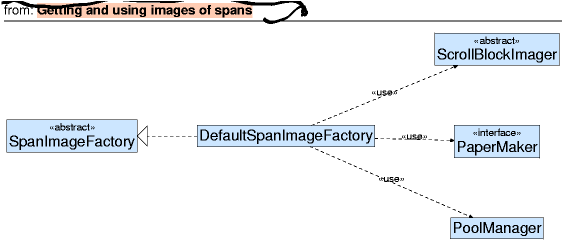Getting and using images of spans
Introduction
Spans (see Alph) are used in Fenfire as the basis of text- and image-based media. An important primitive in the Fenfire platform is showing the image contained in a span. However, to do this efficiently and in accordance with the focus+context principle, we need to load and unload levels of detail of images flexibly.
Libvob provides the basic architectural features for this: (XXX link to memorypool design) competing degradable allocations from a pool of memory, and mipzip files and classes that allow easy loading/unloading of mipmap levels.
What is left for Fenfire to provide is the infrastructure to go from spans to vobs and as easily as possible from the vobs to the usage information to be given to the memory pool.
Requirements
There are several details which will make life difficult:
- For PageImageSpan objects, there are several possible mappings from span to vob, since there are several possible renderings: without background paper, with background paper, with halos or blurring on the background paper &c. Obviously, the code to go from an OpenGL texture to the rendered vob must be pluggable to allow for these features and future extensions in rendering of images of text.
- Both the whole page and fragments of the page may be desired as separate vobs
- The coordinate system of the page in the texture is not fixed between different spans; different resolutions might be used.
- unused spans need to be garbage collected and their textures freed: must be able to handle spaces with 10^6 different span images.
- Need to be able to get width/height of the finished vob - what are its extents in the cs it will be placed to
- Should be able to say (optionally) that the given span is put into an important or unimportant place; although this may be unnecessary if the pixel counting works and culling is used
User-visible interface
The interfaces SpanImageFactory and SpanImageVob in the package org.fenfire.spanimages are the
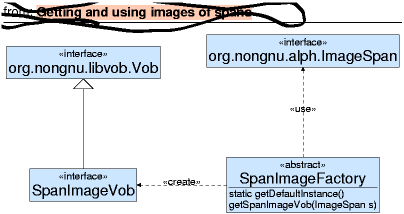
Apart from the option of creating different SpanImageFactory objects with different properties for e.g. page backgrounds, this is all the other classes need to see.
Implementation
The implementations are in org.fenfire.spanimages.gl (once an AWT implementation is made, it will be in the package org.fenfire.spanimages.fuzzybear).
ImageSpan vs PageImageSpan
It is reasonable to expect different treatment of ImageSpan and PageImageSpan objects: for PageImageSpan objects, we will often want libpaper backgrounds and text-enhancing transformations.
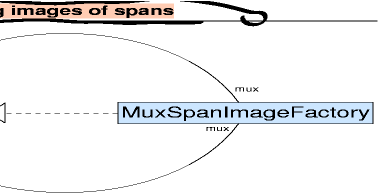
The MuxSpanImageFactory object delegates calls to one factory for PageImageSpan objects and to the other for plain ImageSpan objects.
Caching of SpanImageVob objects
The caching is taken care by another step added to the chain:
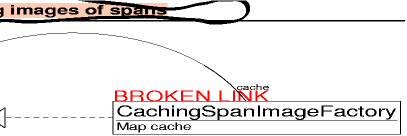
The CachingSpanImageFactory will first check its cache and only if it does not find the object cached will it recreate it.
Repository of loaded textures
The twin classes PageScrollBlockImager and ImageScrollBlockImager take care of mapping spans to OpenGL textures (mipzips).
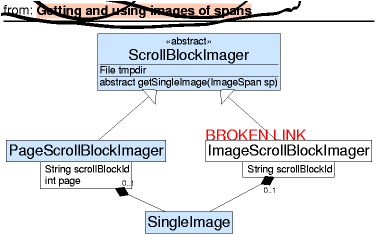
An important architectural feature is that the classes are not static: this allows us to, e.g, plug in filters for the images of PageImageSpan.
The Single Image class
The class used by the repositories to represent the single images is SingleImage.
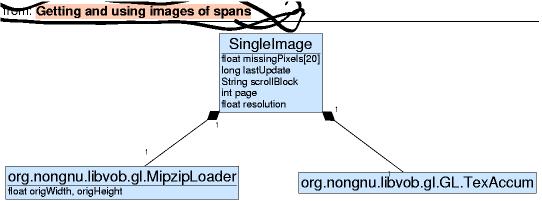
Mapping Images to Paper objects
The libPaper paper abstraction is useful for rendering sections of the images, with various settings. The input should be the TexGen matrix for the paper texture, and the GL texture object.
We may want to change this interface to include the scale of the characters on the paper at some point to allow better text enhancement.

Statistics accumulation and memory pool handling
Now we come to the raison d'etre of this architecture: centralized handling of the feedback from vobscene rendering. The TexAccum class in Libvob is able to accumulate the approximate number of pixels rendered at each mipmap level of each texture. This is collected by the SingleImage .
Because the MemoryPartitioner approach is a bit hard for us to interface with here (the quality - calling time stuff is not optimal for us) we have our own partitioner.
The PoolManager keeps a set of active textures.

